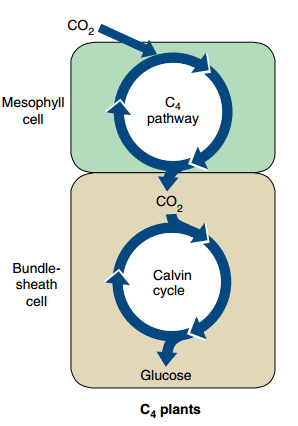Different plants absorb and metabolize the carbon during photosynthesis via different mechanisms.
Botanists classify plants into three groups: C3, C4 and CAM Plants. All these plants perform the same basic mechanism of converting atmospheric Carbon Dioxide into the sugars. The mechanism involved includes variation in the Calvin Cycle.
These variations equip the plant with certain abilities such as to withstand low carbon in the atmosphere, higher temperature and reduced water etc.
Difference Between C3, C4 and CAM
| C3 | C4 | CAM | |
| Plants | Rice, Wheat, Barley | Maize, Sorghum, Sugarcane | Cactuses and other succulents, Pineapple, |
| Enzymes | RuBisCo | PEP | PEP |
| Process | Convert CO2 into a 3 carbon compound PGA | Convert CO2 into 4-carbon intermediate | Collect CO2 during the day and then fix CO2 at night as a 4 carbon intermediate |
| Where Carbon is fixed | All leaf mesophyll cells | Mesophyll cells (MC) and the bundle sheath cells (BSC) | Vacuoles |
| Biomass rates | Mean of -26.5% | Mean of -12.5% | Either C3 or C4 ranges |
C3 Photosynthesis
After the discovery of Calvin Cycle by Melvin Calvin of California University, it was found that the cycle starts when CO2 binds with RuBP and forms PGA which contains three carbon atoms thus this process is also called C3 Photosynthesis.
C3 Photosynthesis is the oldest pathway of Carbon fixation and found in all the taxonomies of the plant kingdom. The C3 pathway is driven by the RuBisCo enzyme
which makes it quite inefficient due to the ability of this enzyme to only fix carbon but oxygen as well, the process called Photorespiration or C2 Photosynthesis.
C3 plants are more vulnerable to damage by increasing temperature. As the temperature increases, it leads to more photorespiration or C2 Photosynthesis. C3 Plants lose 97% of their water to transpiration. In dry areas, the plant closes its stomata to prevent the loss of water. This also decreases the CO2 concentration in leaves and leads to the more photorespiration.
C4 Photosynthesis
C4 is an efficient biochemical modification of the C3 Plants. In this pathway, carbon is captured into the mesophyll cells and transported to the Bundle-sheath cells where Calvin cycle occurs. 
CO2 molecules combine with Phosphoenolpyruvate (PEP) and form 4-carbon compound oxaloacetate, thus the process called C4 Pathway. Oxaloacetate converts to malate and moves to the bundle sheath cells where it dissociates into the Pyruvate and CO2. Pyruvate moves back to mesophyll cells and CO2 stays there because the membrane of mesophyll cells is impermeable to CO2.
The energetic cost of forming glucose via C4 Photosynthesis is almost twice that of C3 Photosynthesis but C4 pathway is an advantage in warmer regions to prevent the Photorespiration.
CAM Photosynthesis
Crassulacean Acid Metabolism Pathway is another plant strategy for efficient photosynthesis by decreasing the photorespiration. This is named after the Crassulaceae plant family in which it was first discovered. In these plants, stomata open in the night and close in the day to prevent water vapour loss.
CAM Plants open stomata in the night and fix CO2 into organic compounds using the C4 pathway. These organic compounds accumulate throughout the night and are decarboxylated during the day to yield high levels of CO2.
In the day, these high levels of CO2 drive the Calvin cycle and minimize photorespiration. Like C4 plants, CAM plants use both C4 and C3 pathways. They differ from C4 plants in that they use the C4 pathway at night and the C3 pathway during the day within the same cells. In C4 plants, the two pathways take place in different cells.
Engineering Photosynthetic Pathways
Agricultural land is shrinking and food insecurity is going to be the biggest problem faced by the global leadership. Improving crop yield is one of the biggest challenges faced by the Plant researchers around the world.
The C4 Plants, evolved from the C3 plants, have high nitrogen and water use efficiency. Those rudimentary genes that formed the C4 pathways are also present in plants. Engineering the C3 plants to C4 or CAM pathway can help scientist to almost double the biomass yield from the same resources.